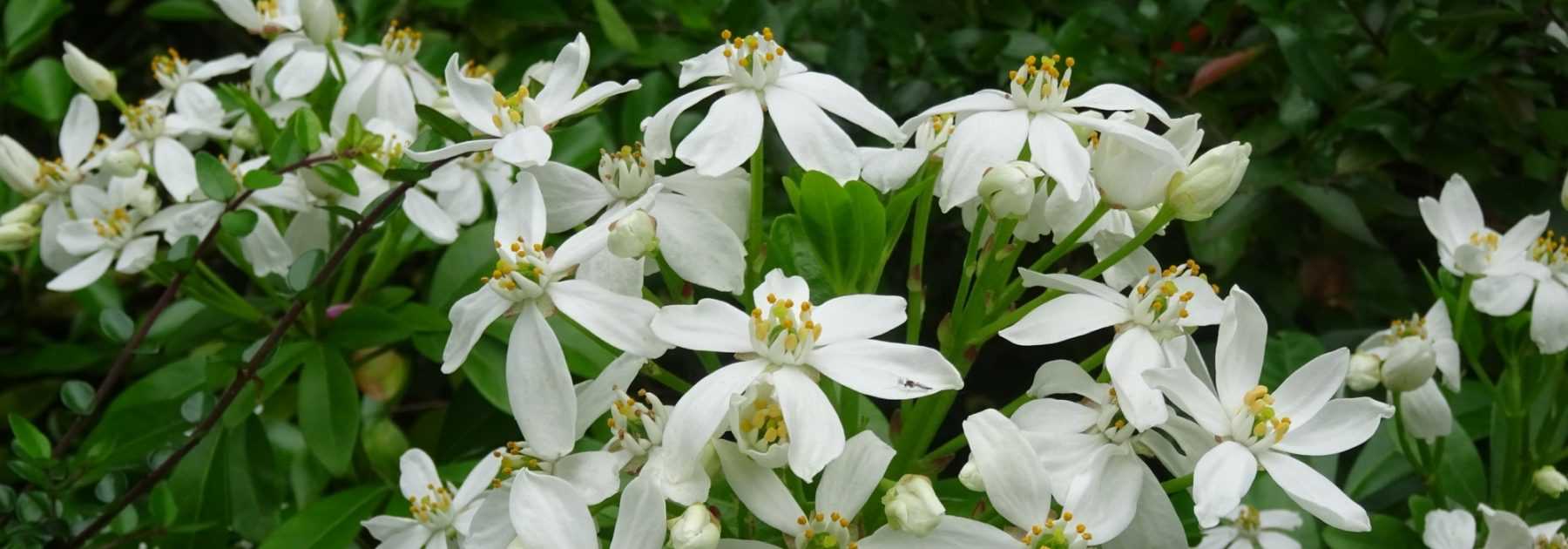
Mexican Orange Blossom, Choisya: Planting, Pruning and Care
Contents
The Mexican Orange Blossom in a nutshell
- Its evergreen, aromatic foliage smells divine
- The white spring blossoms exude a delightful orange blossom fragrance
- Slow-growing yet remarkably hardy, tolerating temperatures down to -15°C
- Easy to grow in any well-drained soil, it withstands drought and coastal winds
- Whether in hedges or containers, it’s a true treasure for gardens and terraces alike
Our expert's word
Its compact shape, modest size, bright evergreen foliage and spring white flowers with a delicate citrus fragrance make the Mexican Orange Blossom or Choisya a precious fragrant shrub for all gardens, even those of modest size.
From the Mexican Orange Blossom ‘Aztec Pearl’ to the choisya ternata ‘Sundance’ or ‘Goldfinger’ with their magnificent golden-yellow leaves, all create a bright focal point in the garden, whether in a hedge, as a standalone feature or grown in a pot on a terrace.
Its glossy, graphic foliage, ranging from dark green to golden yellow, provides a touch of greenery all year round, punctuated by numerous clusters of white flowers in late spring, sometimes blooming again in autumn.
Highly hardy (-10/-15°C), the Choisya is accommodating in any well-drained soil, where it grows slowly, sheltered from cold winds and stagnant moisture.
Resistant to diseases, drought-tolerant and able to withstand sea spray, the Mexican Orange Blossom is an asset in a contemporary garden, a coastal garden or an exotic-inspired garden—its appearance and fragrance are particularly transporting.
It ranks among the most beautiful spring-flowering shrubs. Discover our collection of Mexican Orange Blossom varieties at all price points and let yourself be charmed by this wonderfully fragrant and floriferous shrub.
Botany
Botanical data
- Latin name Choisya ternata
- Family Rutacées
- Common name Oranger du Mexique, Choisya
- Flowering avril, mai et remontée en septembre
- Height 1 à 3 m
- Exposure Soleil, mi-ombre
- Soil type Tous, bien drainé
- Hardiness -10°C/-15°C
The Mexican Orange Blossom, Choisya ternata belongs to the Rutaceae botanical family, like citrus plants. The Choisya genus includes 8 species of evergreen shrubs native to the mountains of Mexico and the southern United States. It has adapted well to our regions where it has become very hardy. The species type Choisya ternata is the most cultivated and the hardiest. It has given rise to several cultivars and hybrids highly prized for their superb bright and graphic foliage, such as ‘Sundance’, ‘Goldfinger’ or ‘Aztec Pearl’.
This shrub has vigorous growth. All Choisya plants form a dense, compact bush with a rounded shape, as wide as tall, reaching up to 3 metres at maturity. Slow to establish, with slow growth, the Choisya needs several years to fill out sufficiently and reach its full potential.
Its green, smooth-barked branches bear graphic and aromatic foliage. Glossy, shiny, and varying from light to dark green, it is the main attraction of the shrub. The evergreen, shiny, opposite, oval, and palmate leaves divide into 3 or 7 leaflets. Very narrow, they measure from 2 cm to 8 cm long and are grouped in threes (hence the name ternata, meaning ‘in threes’) and attached to the stem by a long petiole. Dark green, bright yellow (Choisya ternata ‘Sundance’) or golden yellow (‘Goldfinger’) in spring, they turn greener later. When crushed, they release a strong, fresh, and spicy fragrance of orange peel and green pepper.
The Mexican Orange Blossom offers an abundant spring flowering that also emits a delicate citrus fragrance. Clusters of small, usually pure white flowers, 2 to 3 cm in diameter, grouped in corymbs at the branch tips, bloom profusely in May-June and sometimes rebloom in autumn, in September-October (until November-December in mild climates). They open into star-shaped corollas, consisting of 5 to 6 well-spread white petals hiding a bouquet of bright orange-anthered stamens at their centre. The Choisya ‘Apple Blossom’ stands out with its bicoloured, pink-tinged flowers. Their orange blossom scent attracts pollinating insects, including bees and butterflies. They give way to small capsule-shaped fruits that release seeds when mature.
Hardy and drought-resistant, the Mexican Orange Blossom is easy to grow in sun or partial shade in most regions. It thrives in any fresh, rich, and well-drained soil, even slightly acidic. Hardy down to -12°C to -15°C, its hardiness may sometimes be challenged north of the Loire during prolonged frost. It prefers warm, sunny locations and shelter from cold winds, which can scorch its leaves.
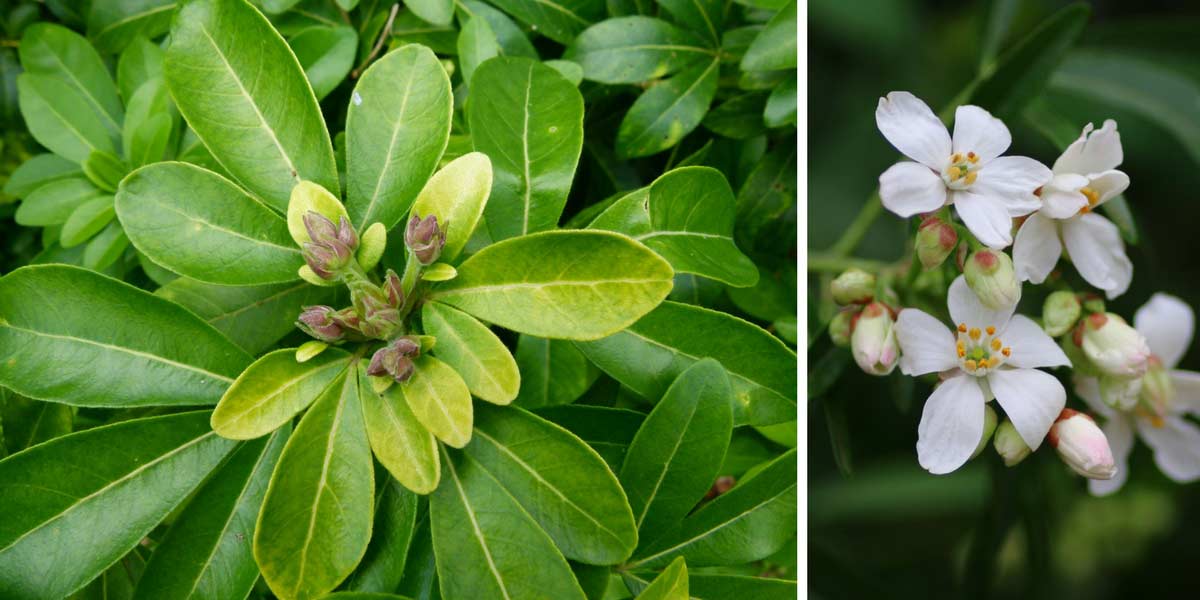
The evergreen foliage and fragrant flowering of the Mexican Orange Blossom are its main assets
With its evergreen foliage, exotic appearance, and fragrance, it makes a lovely decorative feature year-round in all contemporary gardens, with exotic inspiration, and even in coastal gardens. The Choisya lends itself to multiple uses; near an entrance to enjoy its delicate fragrance, in a large border, in a large pot on a terrace or balcony, as a loose hedge, alongside Escallonia, old roses, Abelia, or dwarf buddleias.
Read also
Take extra care of your evergreen shrubsSpecies and main varieties
In addition to the common Choisya ternata variety, there are a few remarkable cultivars and hybrids prized for their luminous foliage that looks beautiful all year round, such as ‘Sundance‘ with golden leaves, ‘Goldfinger’, or ‘Aztec Pearl’ with its finely cut, highly graphic foliage.
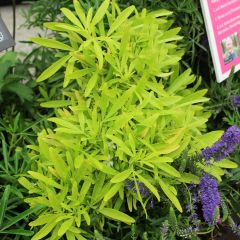
Choisya Goldfinger - Mexican Orange Blossom
- Flowering time June, July
- Height at maturity 2 m

Choisya Aztec Pearl - Mexican Orange Blossom
- Flowering time June, July
- Height at maturity 2 m
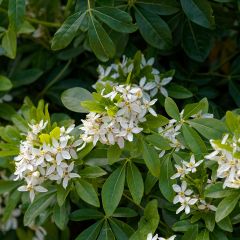
Choisya ternata - Mexican orange blossom
- Flowering time May to October
- Height at maturity 2 m
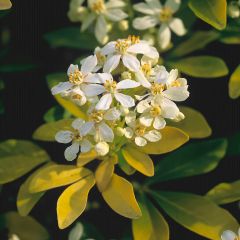
Choisya ternata Sundance - Mexican orange blossom
- Flowering time July to November
- Height at maturity 2 m

Choisya ternata Apple Blossom - Mexican Orange Blossom
- Flowering time May to October
- Height at maturity 1,20 m
Discover other Choisya - Mexican Orange Blossom
Planting
Where to plant?
Choisya grows throughout France. While it tolerates shade in regions with hot summers, in colder climates it requires sun and a sheltered position away from icy, drying winds. In regions south of the Loire, its foliage tends to scorch in full sun and therefore benefits from some shade. However, avoid overly dense shade, as it needs light to flower well.
Yet behind its exotic appearance lies a vigorous, handsome shrub that, once well-established, can withstand brief frosts down to -15°C, as well as summer drought. It’s an excellent shrub for coastal gardens, being resistant to salt spray.
It thrives in rich, well-drained soils. This low-maintenance shrub grows in any light, humus-rich soil, even slightly acidic or mildly alkaline, as long as drainage is good: it dislikes waterlogged soils in winter, especially when young.
Versatile and evergreen, this shrub lends itself to multiple uses and adapts to all gardens; equally suited as a standalone specimen, in a bright, informal hedge, at the front of a shrub or mixed border, or in a large pot on a terrace or balcony to enjoy its delicate citrus fragrance. Choisya is a shrub that retains interest all winter, when other plants are dormant.
→ Read also: What is the best spot to plant a Mexican orange blossom (Choisya)?
When to plant?
Planting times vary by region. In colder, frost-prone areas, planting in spring (March to April) after the harshest frosts will encourage establishment. In Mediterranean and milder regions, plant in late summer, from September to November.
How to plant?
The soil should be light and aerated. For an informal hedge, space Choisya plants 60 to 80 cm apart.
- Soak the rootball in a bucket of water before planting
- Avoid waterlogged areas: add pumice or a layer of clay pebbles at the bottom of the planting hole to ensure good drainage (its roots dislike stagnant moisture, especially in winter).
- Dig a hole three times wider and deeper than the pot.
- Plant the shrub, mixing half compost with garden soil to backfill the hole.
- Water thoroughly
- In summer, water and mulch to retain soil moisture with a generous organic mulch of pine bark, or plant small perennials around the base to protect roots and reduce watering needs
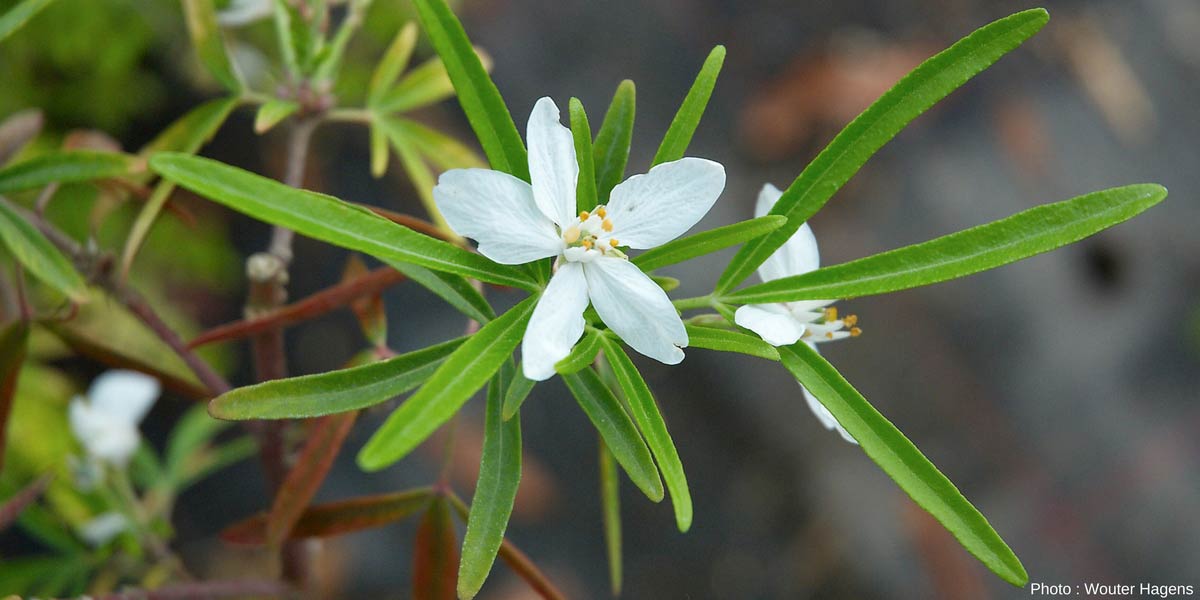
Choisya offers beautiful foliage diversity, like this ‘Aztec Pearl’ variety
Growing Mexican orange blossom in pots
It thrives in containers in regions south of the Loire. Its compact size makes it ideal for this purpose. It will flourish for many years in sun or partial shade, in a large container filled with a fresh, very free-draining mix of compost, well-rotted manure, river sand and good garden soil. Choose a sizeable pot (30–40 cm diameter, ~30L capacity) and add a layer of gravel or clay pebbles at the base. Potted plants require closer watering attention. Apply mulch or plant small perennials to maintain soil moisture in summer. Repot every 2–3 years. Each spring, top-dress with compost. During severe frosts (-20°C), protect with horticultural fleece.
→ Also read our guide: 7 Mexican orange blossoms to grow in pots.
Maintenance, Pruning and Care
A well-established Mexican Orange Blossom requires little care to maintain its health. Water regularly during the first year after planting to encourage establishment and during prolonged heatwaves. In subsequent years, it will tolerate drought very well.
Pruning is unnecessary during the first few years. Only intervene after 3 or 4 years to remove any dead or winter-damaged branches, or to perform light pruning to maintain a compact shape and encourage a second flowering in autumn. In May-June, after flowering, cut back the current year’s growth by half.
In regions north of the Loire, protect the shrub from severe frost and snow, which can scorch its leaves, using winter fleece. Be cautious with heavy or clay soils; lighten the soil with gravel if needed, as waterlogged winter soils can compromise the otherwise respectable hardiness of the Choisya.
Apply a thick layer of organic mulch (pine bark or needles, leaf mould), renewed annually, to keep the roots cool during summer heat.
The Choisya ternata is a hungry plant – in spring, you can top-dress with well-rotted compost.
→ Learn more with our advice sheet on pruning Mexican Orange Blossom and winter protection for Mexican Orange Blossom
Diseases and potential pests
Very resilient, the Mexican Orange Blossom is not easily troubled. When grown in good conditions, it shows little susceptibility to diseases and pests. Snails in spring may occasionally feast on young shoots.
Its main concerns are fungal diseases caused by fungi that develop in poorly drained soil or where moisture stagnates around the roots. Its primary enemy: Phytophthora, a soil-borne fungus whose attack can kill it outright. The foliage yellows, branches wither, and the plant dies rapidly. These issues are rare if cultivation advice is followed: plant in healthy soil, avoid waterlogging, and improve drainage. In heavy or clay soil, lighten the earth with gravel and compost, as waterlogged winter soils also reduce this shrub’s hardiness.
→ Read also: Diseases and Pests of the Choisya or Mexican Orange Blossom
Propagation
The Mexican Orange Blossom is easily propagated by cuttings.
By semi-ripe cuttings
- After flowering, between July and September, take new semi-ripe (semi-woody) shoots from the current year, 8 to 10 cm long.
- Remove all leaves from the lower part of the shoot, keeping only 2-3 leaves maximum.
- Make a 2 to 3 cm long incision in the bark
- Plant the cuttings in a light, well-draining substrate composed of 50% sand and 50% peat
- Place them under a cold frame at 18°C
- Regularly mist the cuttings with a sprayer
- Pot them up as soon as new leaves have grown
- Repot the following spring and keep them in pots for 1 year before planting them out in the ground
→ Learn more about propagating Mexican Orange Blossom in our advice sheet!
Pairing
Highly versatile, the Mexican Orange Blossom is inspiring for a contemporary garden with an exotic flair as well as for a coastal garden, where it can be used to create a loose informal hedge or to adorn a wall alongside other shrubs like Abelia, or in mixed borders with perennials such as Heucheras, Rodgersias, or Astrances.
In larger borders, it will look stunning paired with Escallonias, old-fashioned roses, or dwarf buddleias. A C. ternata ‘Goldfinger’ will add an exotic touch to a planting scheme alongside a non-spreading bamboo like Fargesia murielae ‘Bimbo’, a Japanese forest grass Hakonechloa macra ‘All Gold’, and a Pyracantha ‘Soleil d’Or’.
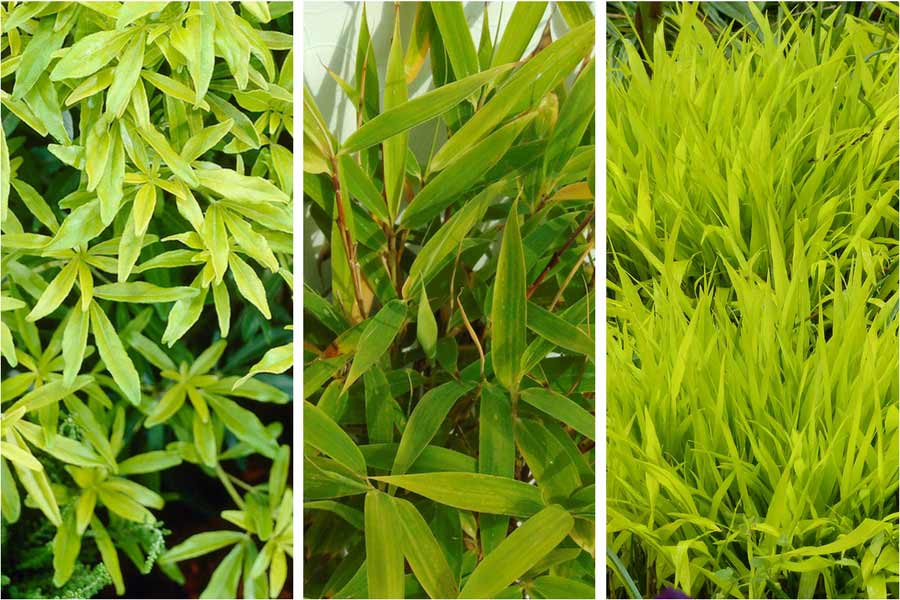
A luminous combination featuring Choisya ternata Goldfinger, Fargesia murielae Bimbo, and Hakonechloa macra All Gold
This fragrant shrub makes an excellent evergreen backdrop for winter and spring flowers. It can be paired with more exuberant plants and lighter foliage, such as ceanothus, ornamental grasses, or rockroses. A spring-flowering climber like a Clematis will elegantly weave through the foliage of a Choisya ternata.
The Choisya ternata ‘Sundance’, with its bright yellow-green foliage—nearly golden in full sun—creates a striking contrast with blue flowers like those of creeping bugle (Ajuga), Corydalis, irises, Brunneras, or hardy geraniums.
→ Also discover 7 ideas for pairing Choisya
Useful resources
- Subscribe!
- Contents


































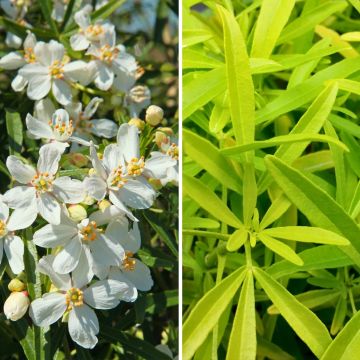
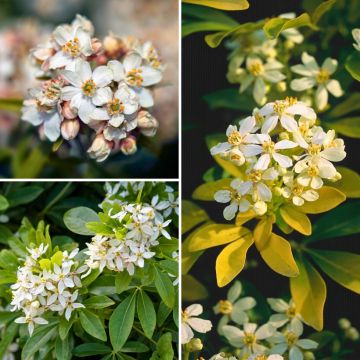
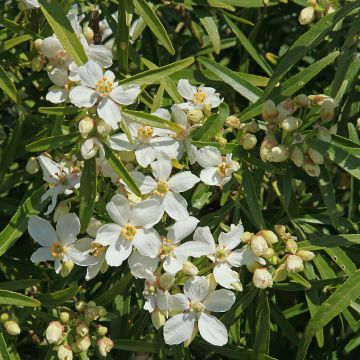






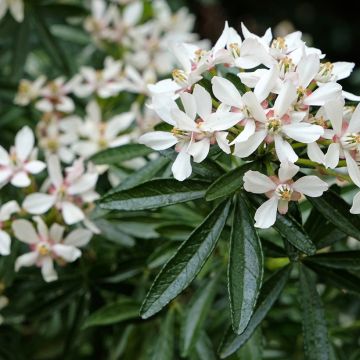
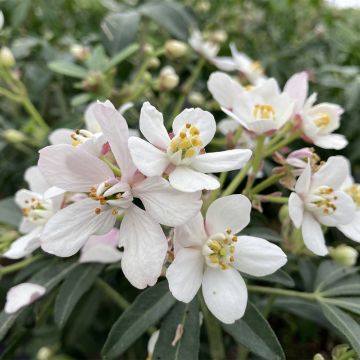
Comments